The season’s first warm weather brought significant snowmelt into the McKenzie River watershed and over the majestic Sahalie Falls and Koosah Falls.
Trip Report:
Volunteer Leader: Mark Hougardy | Organization: Eugene-based Hiking Club | Dates: May 2018 | Participants: 5 | Type: Hiking and Car Camping
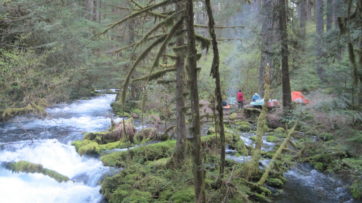 Our plan to hike to Tamolitch Falls (Blue Pool) was cut short when a sign stated a mile of trail was closed because water had flooded the path in places to a depth of 3 feet. Even with the closure, there was plenty to appreciate further upstream at Clear Lake with its crystalline waters and turquoise colored Great Spring. Animals that were seen along the trail also appeared to appreciate the warmer weather as fish jumped in the lake, several species of birds flew overhead, and a garter snake warmed itself on the rocks. In shaded areas winter still managed to hold its grip as large patches of snow remained. Springs spontaneously appeared on the trail sometimes forming small ponds, and at one point, all of us were mesmerized by a plate-sized vortex that had formed in such a pool. After a solid day of hiking, we visited Belknap Hot Springs for a relaxing soak. Because we timed our visit before the Memorial Day crowds the U.S. Forest Service campground was basically empty. Our campsite was green with moss and located next to a white rushing stream that looked like it was born from a Tolkien novel. The next day we enjoyed the comfort of a morning campfire, broke camp, and explored several more miles of trail before heading home.
Our plan to hike to Tamolitch Falls (Blue Pool) was cut short when a sign stated a mile of trail was closed because water had flooded the path in places to a depth of 3 feet. Even with the closure, there was plenty to appreciate further upstream at Clear Lake with its crystalline waters and turquoise colored Great Spring. Animals that were seen along the trail also appeared to appreciate the warmer weather as fish jumped in the lake, several species of birds flew overhead, and a garter snake warmed itself on the rocks. In shaded areas winter still managed to hold its grip as large patches of snow remained. Springs spontaneously appeared on the trail sometimes forming small ponds, and at one point, all of us were mesmerized by a plate-sized vortex that had formed in such a pool. After a solid day of hiking, we visited Belknap Hot Springs for a relaxing soak. Because we timed our visit before the Memorial Day crowds the U.S. Forest Service campground was basically empty. Our campsite was green with moss and located next to a white rushing stream that looked like it was born from a Tolkien novel. The next day we enjoyed the comfort of a morning campfire, broke camp, and explored several more miles of trail before heading home.


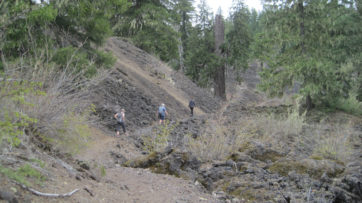
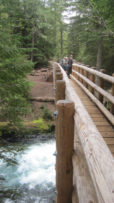 Â Â
  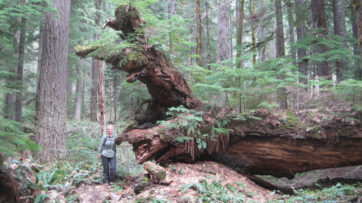
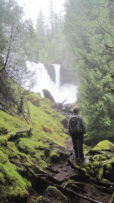





 It’s difficult to imagine today, but between 1907 and 1927 streetcars (commonly referred to as trolleys) ran along 18-miles of electrified tracks in Eugene, Oregon. Their comforting clickety-clack as the wheels passed over connections in the tracks were heard on four routes in this city of 11,500 people. Only the finest cars were used and each was superbly-crafted with heaters and rattan seats. At 45-feet in length, they could carry up to 100 passengers. The cost per trip was 5 cents for a child and 10 cents for an adult. Our walk will help re-discover this curious icon of the early 1900s using old photos and traversing the Fairmount trolley’s 5.5-mile route. We walked the Fairmount’s route in its direction of travel from the train station, through downtown, across the University of Oregon’s picturesque campus, passing historic residential neighborhoods, crossing over some of the last remaining visible tracks, and back. Although many of the trolley’s tracks are not visible today, look carefully, many miles of track from this time are hidden just under the pavement.
It’s difficult to imagine today, but between 1907 and 1927 streetcars (commonly referred to as trolleys) ran along 18-miles of electrified tracks in Eugene, Oregon. Their comforting clickety-clack as the wheels passed over connections in the tracks were heard on four routes in this city of 11,500 people. Only the finest cars were used and each was superbly-crafted with heaters and rattan seats. At 45-feet in length, they could carry up to 100 passengers. The cost per trip was 5 cents for a child and 10 cents for an adult. Our walk will help re-discover this curious icon of the early 1900s using old photos and traversing the Fairmount trolley’s 5.5-mile route. We walked the Fairmount’s route in its direction of travel from the train station, through downtown, across the University of Oregon’s picturesque campus, passing historic residential neighborhoods, crossing over some of the last remaining visible tracks, and back. Although many of the trolley’s tracks are not visible today, look carefully, many miles of track from this time are hidden just under the pavement.























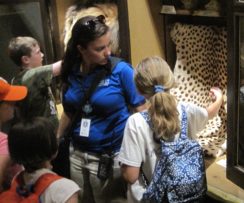

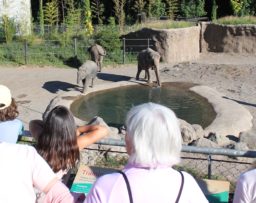













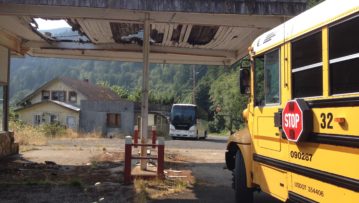















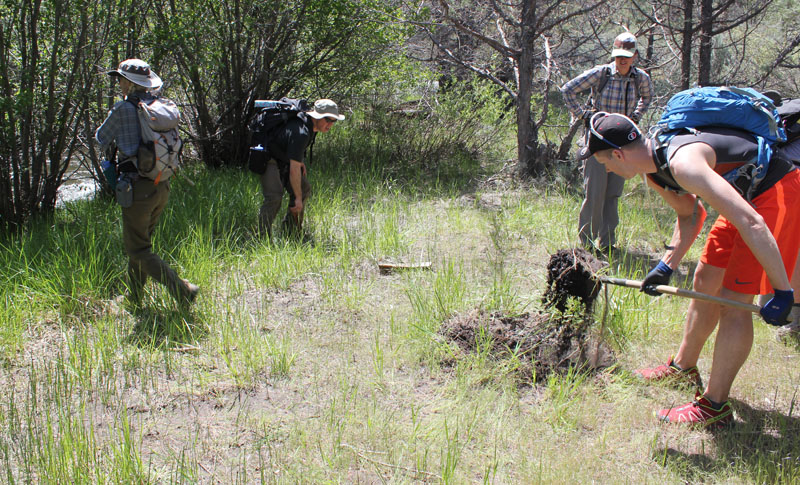
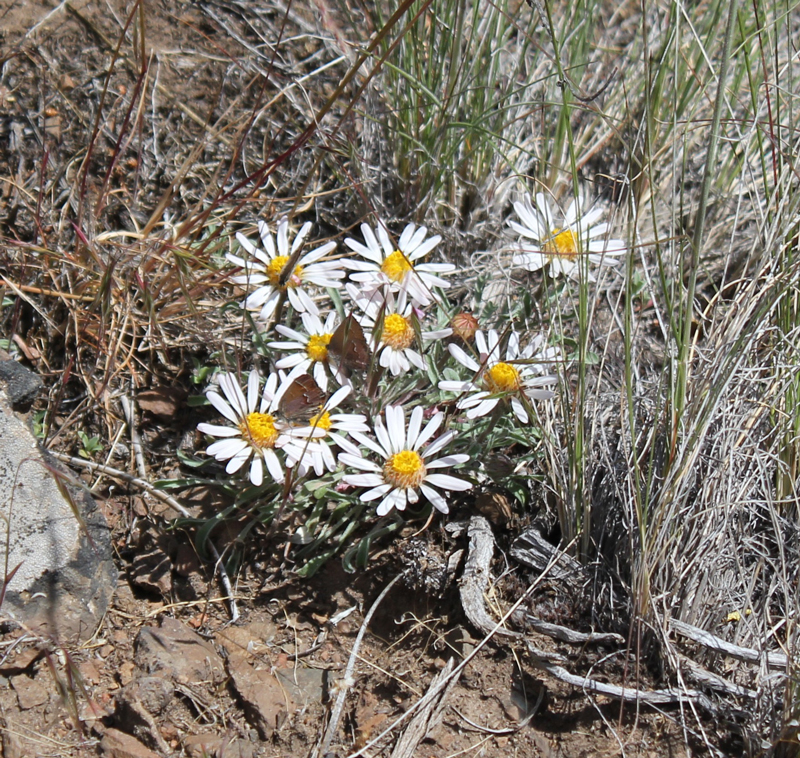
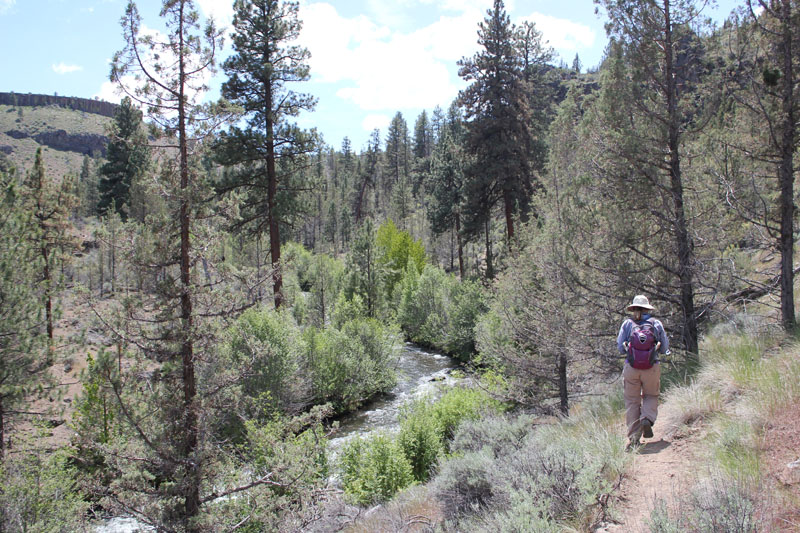
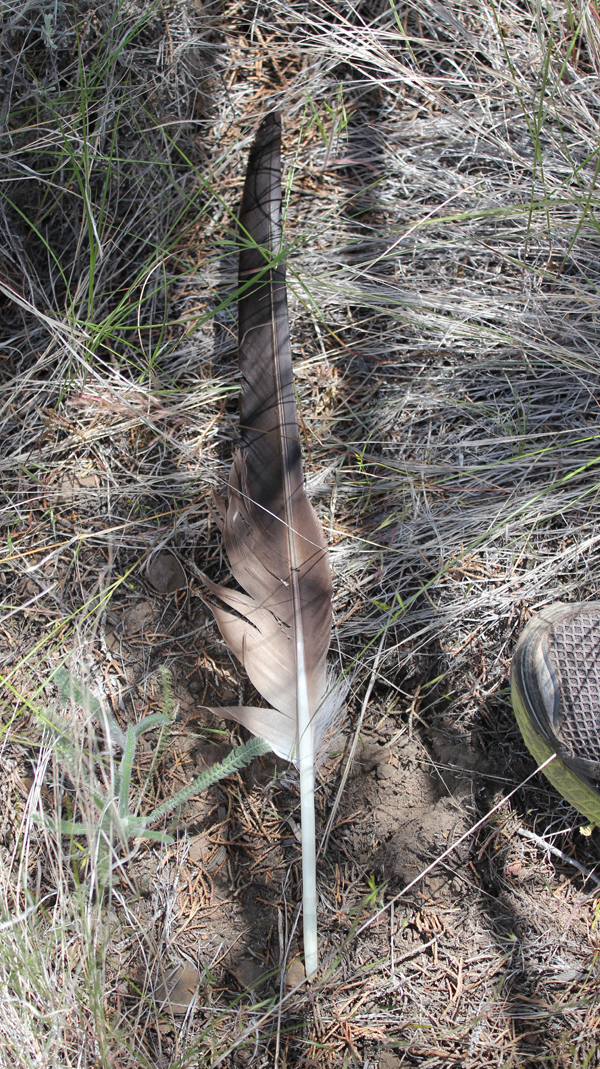
 Volunteer Organizer: Mark Hougardy | Location: Eugene-based Hiking Group Lodge | Date: April 2017 | Duration: 1 day | Participants: 80+ | Type: Outreach Event
Volunteer Organizer: Mark Hougardy | Location: Eugene-based Hiking Group Lodge | Date: April 2017 | Duration: 1 day | Participants: 80+ | Type: Outreach Event





















 That’s me with the apple. The lodge’s owners Hal and Tonia quickly welcomed us as we arrived at their retreat/garden/camp in the woods. Hal offered us delicious Honey Crisp apples directly off the tree to enjoy on our hike. [Photo by Darko]
That’s me with the apple. The lodge’s owners Hal and Tonia quickly welcomed us as we arrived at their retreat/garden/camp in the woods. Hal offered us delicious Honey Crisp apples directly off the tree to enjoy on our hike. [Photo by Darko] Our 8-mile hike started up a reclaimed forest road, past cedar trees used by mountain lions for scratching, across the deep ravine where a rope was needed (shown), and finally to a deceptively steep forest road.
Our 8-mile hike started up a reclaimed forest road, past cedar trees used by mountain lions for scratching, across the deep ravine where a rope was needed (shown), and finally to a deceptively steep forest road.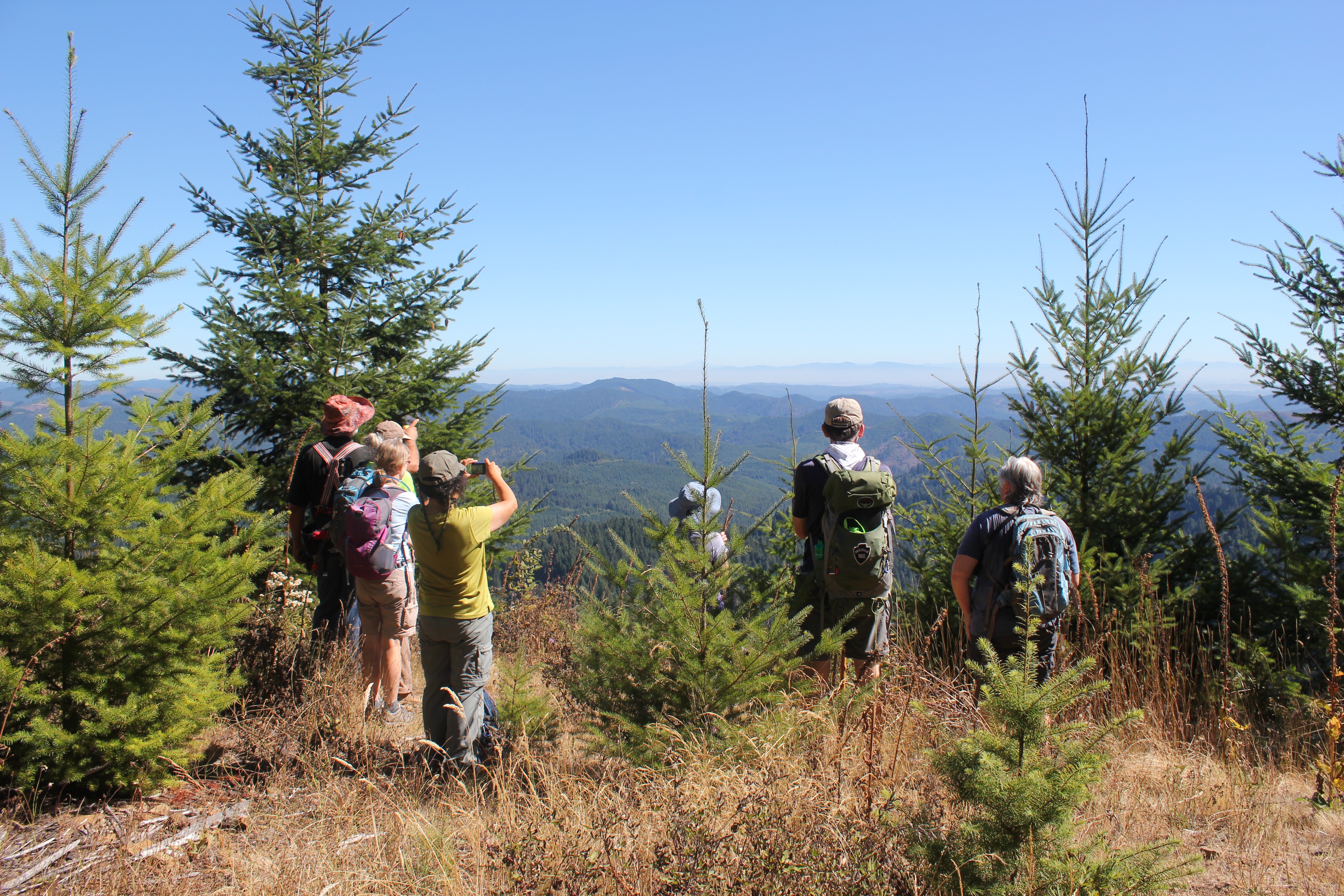 After a good heart-pounding climb, we arrived at the “Secret Spot,†the highest location within the Coast Range in Lane County. We had climbed roughly 1,600 feet from where we started but the view made up for it. Looking east we could see 130+ miles in the distance: in the north, Mt Hood, followed by Mt, Jefferson, Three-Fingered Jack, North, Middle and South Sister, Mt. Bachelor, and finally 125 miles further south, Diamond Peak.
After a good heart-pounding climb, we arrived at the “Secret Spot,†the highest location within the Coast Range in Lane County. We had climbed roughly 1,600 feet from where we started but the view made up for it. Looking east we could see 130+ miles in the distance: in the north, Mt Hood, followed by Mt, Jefferson, Three-Fingered Jack, North, Middle and South Sister, Mt. Bachelor, and finally 125 miles further south, Diamond Peak. We rested, enjoyed some lunch, and then traversed back down the forest road to several turnoffs, and a forest trail that deposited us back at Big Bear. That evening we shared a potluck with neighbors; everyone’s gardens were abundant and we and enjoyed the bounty of harvest-time meals. Later that evening we enjoyed guitar folk music by the fire and enjoyed freshly picked grapes (shown below). In the morning we hung out, explored the local creek, enjoyed the garden, and planned a route for a 42-mile, 4-day backpacking trip to the coast for next spring.
We rested, enjoyed some lunch, and then traversed back down the forest road to several turnoffs, and a forest trail that deposited us back at Big Bear. That evening we shared a potluck with neighbors; everyone’s gardens were abundant and we and enjoyed the bounty of harvest-time meals. Later that evening we enjoyed guitar folk music by the fire and enjoyed freshly picked grapes (shown below). In the morning we hung out, explored the local creek, enjoyed the garden, and planned a route for a 42-mile, 4-day backpacking trip to the coast for next spring.

 On the way, we encountered several snowfields, one of which was very steep, but the stunning views from the top were well worth the extra effort in getting there. In the distance, Mount Scott was enticingly clear of snow, though we later learned it was impossible to reach because several miles of the eastern rim highway was closed for repairs. Returning down the mountainside we visited the small loop trail of Godfrey Glen where we collected trash that uncaring visitors had left. We collected enough garbage to fill a large bag! That evening we sat around the campfire and commented on the number of stars that were visible, where was the rain? All was calm until 2 am when the rain arrived and temperatures lowered to just above freezing. Our two members in their “good deal†tent had a cold and wet night.
On the way, we encountered several snowfields, one of which was very steep, but the stunning views from the top were well worth the extra effort in getting there. In the distance, Mount Scott was enticingly clear of snow, though we later learned it was impossible to reach because several miles of the eastern rim highway was closed for repairs. Returning down the mountainside we visited the small loop trail of Godfrey Glen where we collected trash that uncaring visitors had left. We collected enough garbage to fill a large bag! That evening we sat around the campfire and commented on the number of stars that were visible, where was the rain? All was calm until 2 am when the rain arrived and temperatures lowered to just above freezing. Our two members in their “good deal†tent had a cold and wet night. We explored the Visitor’s Center, the Sinnott Memorial Overlook (featuring an indoor exhibit room) and the gift shop to escape the fog, wind, rain, and occasional snow flurries. The fog was so thick we could not see the lake or a few hundred feet in front of us. In the afternoon we moved below the cloud line to hike the picturesque Annie Creek trail. Although a short hike, it was very picturesque. Laurie and Brad had reservations at the Crater Lake Lodge for dinner, they generously increased their table size to include all of us so we could get out of the rain and have some warm food. About 8 pm that evening the sky cleared and at first, the temperatures seemed warm. The group campfire that evening had just half of the group, the remainder had gone to bed early. The two members in the “good deal†tent had another cold and memorable night. In the middle of the night I awoke and was stunned by the visibility of the night sky – there were thousands of stars! My tent thermometer showed that temperatures had dropped into the upper twenties.
We explored the Visitor’s Center, the Sinnott Memorial Overlook (featuring an indoor exhibit room) and the gift shop to escape the fog, wind, rain, and occasional snow flurries. The fog was so thick we could not see the lake or a few hundred feet in front of us. In the afternoon we moved below the cloud line to hike the picturesque Annie Creek trail. Although a short hike, it was very picturesque. Laurie and Brad had reservations at the Crater Lake Lodge for dinner, they generously increased their table size to include all of us so we could get out of the rain and have some warm food. About 8 pm that evening the sky cleared and at first, the temperatures seemed warm. The group campfire that evening had just half of the group, the remainder had gone to bed early. The two members in the “good deal†tent had another cold and memorable night. In the middle of the night I awoke and was stunned by the visibility of the night sky – there were thousands of stars! My tent thermometer showed that temperatures had dropped into the upper twenties.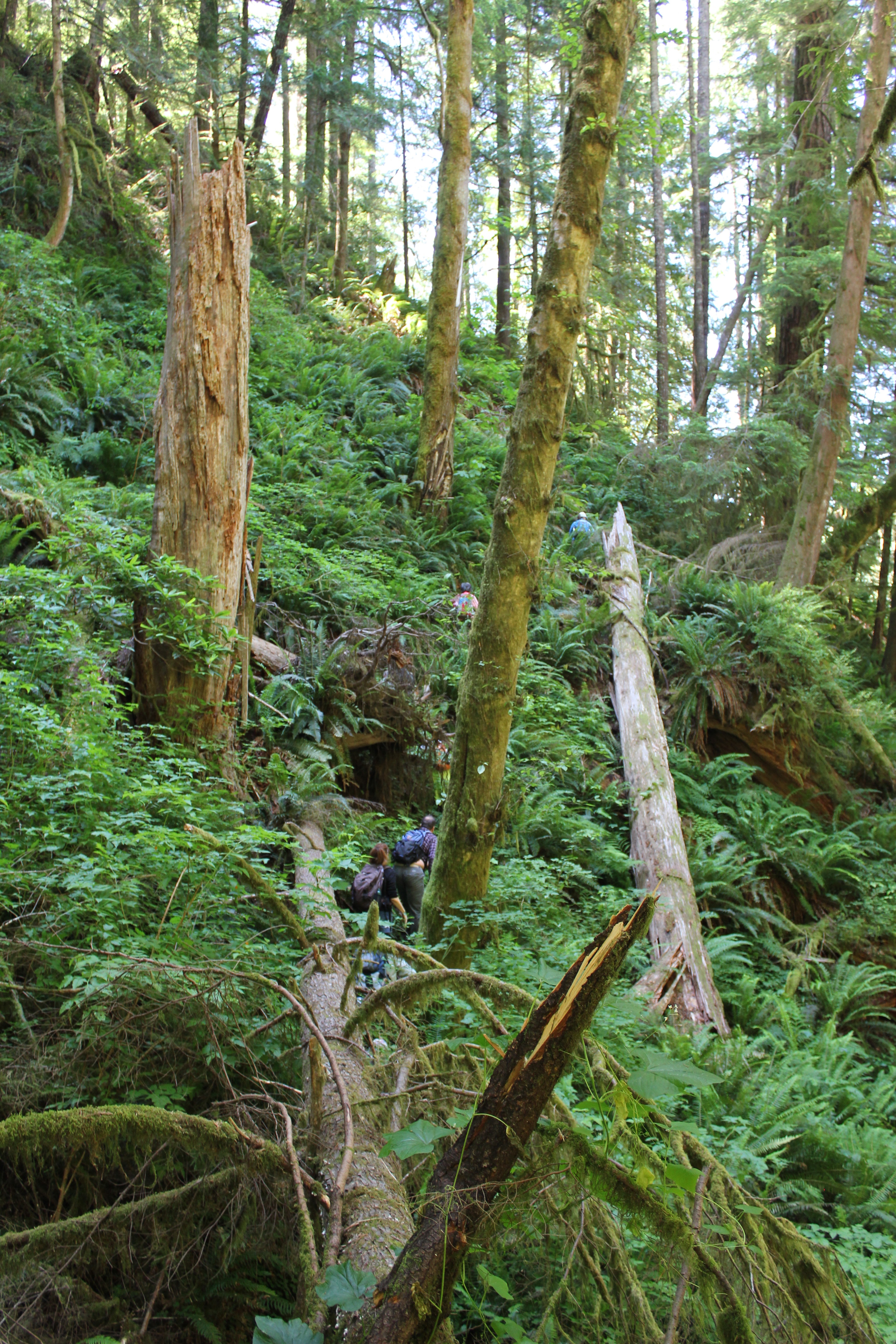 We parked at a junction and walked down an old logging road that was being reclaimed by the forest. Then we disappeared into the bushes, venturing down an elk trail. Posted on a tree was a sign that told us this was not the path to the Devil’s Staircase waterfall and unless you’re prepared to stay the night, and have Search and Rescue to look for you, to turn back. Fortunately, we had a guide for our inaugural visit.
We parked at a junction and walked down an old logging road that was being reclaimed by the forest. Then we disappeared into the bushes, venturing down an elk trail. Posted on a tree was a sign that told us this was not the path to the Devil’s Staircase waterfall and unless you’re prepared to stay the night, and have Search and Rescue to look for you, to turn back. Fortunately, we had a guide for our inaugural visit. A forest of Salmonberries obstructed our path, so we made a trail straight up a ridge, then down into a forest of sword ferns. The ferns stood at five to six feet in height, so they engulfed us all and many of the shorter members traveled with their arms raised straight overhead. These tranquil glens often hid downed logs and it was easy to twist ankles or slam shins.
A forest of Salmonberries obstructed our path, so we made a trail straight up a ridge, then down into a forest of sword ferns. The ferns stood at five to six feet in height, so they engulfed us all and many of the shorter members traveled with their arms raised straight overhead. These tranquil glens often hid downed logs and it was easy to twist ankles or slam shins. A fallen giant became our catwalk above the salmonberries, foxgloves, and ferns. We crossed a creek, but could barely see the water because of the thick undergrowth. Scampering down the side of the massive tree, we squatted and crawled through a small jungle, then emerged at the root base of the fallen giant – it was 25 feet tall!
A fallen giant became our catwalk above the salmonberries, foxgloves, and ferns. We crossed a creek, but could barely see the water because of the thick undergrowth. Scampering down the side of the massive tree, we squatted and crawled through a small jungle, then emerged at the root base of the fallen giant – it was 25 feet tall! In front of us was the Dark Grove, a cathedral of 8-foot wide Douglas Fir trees. The trees were dark in appearance, the result of fire about 150 years earlier. Touching the bark a charcoal residue was imprinted on fingers. The tree model is Becky Lipton.
In front of us was the Dark Grove, a cathedral of 8-foot wide Douglas Fir trees. The trees were dark in appearance, the result of fire about 150 years earlier. Touching the bark a charcoal residue was imprinted on fingers. The tree model is Becky Lipton. Crossing back across the fallen giant, we stood at the base of one of the largest trees we saw that day. Eight people stood at its base, arms outstretched and hands grasped. They counted one, two, three… their calls became muffled as they rounded the opposite side…the voices returned and the loop stopped – at seven and a half people! This immense tree was somewhere between 35 to 40 feet in circumference! Several hikers mentioned they felt like kids in a giant outdoor playground.
Crossing back across the fallen giant, we stood at the base of one of the largest trees we saw that day. Eight people stood at its base, arms outstretched and hands grasped. They counted one, two, three… their calls became muffled as they rounded the opposite side…the voices returned and the loop stopped – at seven and a half people! This immense tree was somewhere between 35 to 40 feet in circumference! Several hikers mentioned they felt like kids in a giant outdoor playground.